Is Semrush worth your money? And is it the right tool for your needs? This Semrush review will take an in-depth look at these questions, and much more.
The Semrush tool is one of the leading SEO software platforms in the market. It comes with a variety of SEO features to help you get more organic traffic from search engines. But it’s not for everyone!
So in this Semrush review, we’ll see where Semrush shines the most, what it lacks, and whether you should consider getting a Semrush subscription.
What is Semrush?
The Semrush SEO tool is a big piece of software that helps improve your website and SEO. You can use it to get different types of data about your website, or those of competitors. Using this data, you find opportunities that help you get an edge.
For example, Semrush can help you analyze:
- What people are searching online
- What topics you can create content for to get more traffic
- Which websites you can target for link-building outreach
- What technical aspects you can improve on your website
And this is just the tip of the iceberg. The Semrush tool comes with hundreds of small and large features to help improve your online presence. We will go through some of these features in this Semrush review.
Case in point: Edelweiss Bakery. When faced with a shortage of orders, it used the Semrush SEO tool to identify what to optimize in three key areas: main SEO, content marketing, and ecommerce.
And Semrush helped them improve both organic traffic and search rankings for multiple keywords. Using Semrush, the company was able to boost its mobile organic traffic by 460%.

Image Source: Semrush
Who is Semrush for?
Semrush has been designed with a general business audience in mind. That said, an SEO background will definitely help you get more from the software.
It’s best suited for experienced bloggers, digital marketing professionals, and agencies for whom SEO is serious business. Because that’s when they’d be willing to invest $100 or more per month on such a tool.
Semrush key features
Now that you know what Semrush is, let’s continue this Semrush review with some of the core SEO tools you get with your subscription.
Domain Analysis
A typical SEO project starts with domain analysis, in which you get an overview of the strength of your domain from an SEO perspective. Based on this data, you determine the right approach to improve your website’s SEO.
Alternatively, you can analyze a competitor’s domain and compare the results with yours. So you get an accurate sense of the time, budget, and efforts you’ll need to outrank the rival.
Domain analysis also helps you shortlist websites that you might approach to build backlinks. That’s because a backlink from a high authority domain holds more value than a low-value domain.
To conduct a domain analysis in the Semrush SEO tool, just enter the domain URL in the ‘domain overview’ section. And you’ll get a detailed report on where the domain stands.
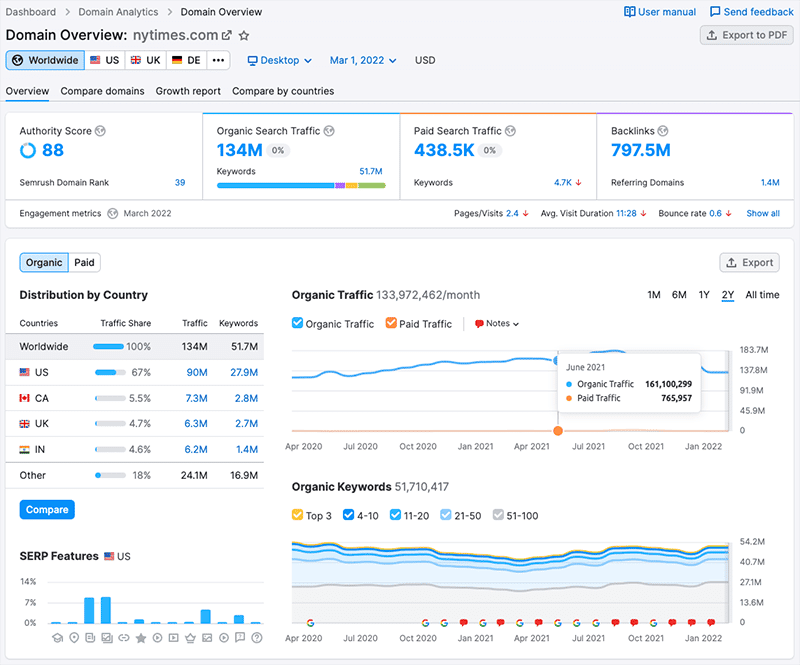
The metric that’ll give you the quickest assessment of your website is the ‘authority score.’
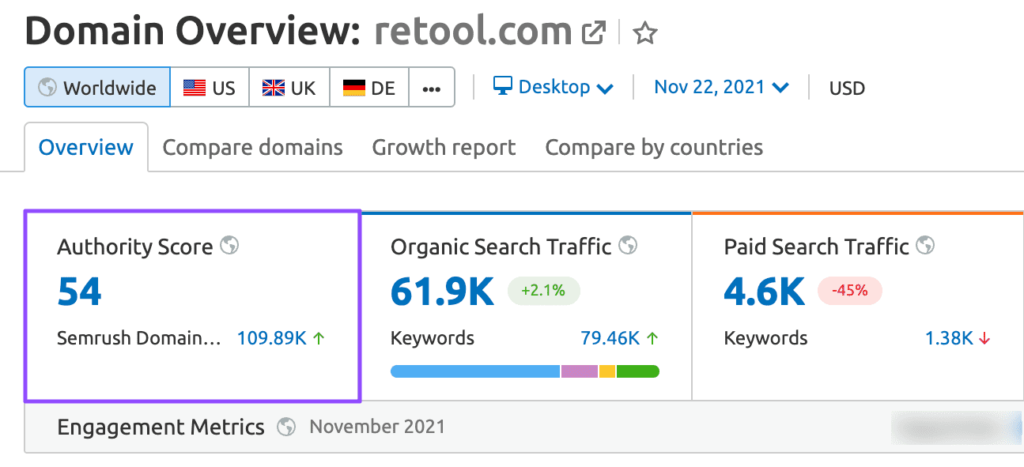
There’s one thing you need to keep in mind when you review the different metrics in your report. While most of the numbers you’re seeing are based on hard data, the traffic numbers are not. They are estimates. So they may not always be 100% correct.
Also, a great feature worth mentioning here is the competitive positioning map. It’s a visual that shows you where your site stands against similar players in your niche.
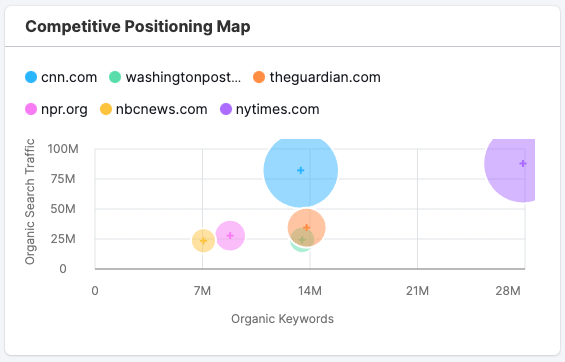
Another noteworthy report is the breakdown of the search intent behind the keywords a domain ranks for. This gives you a sense of why people click on certain links when they search for a keyword. For example, do they need information on a topic, or do they want to make a purchase?
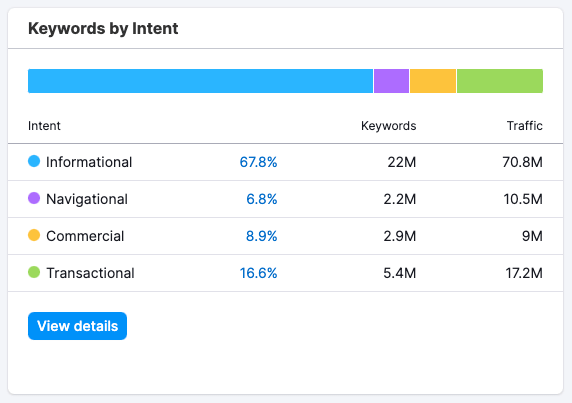
This is crucial data as search intent is one of the key SEO trends that marketers are focusing on these days. According to Gartner, over 70% of marketers will utilize third-party intent data for sales and marketing by the end of 2022.
However, one key data point we found missing in the Semrush tool is the cost estimate. For example, when you conduct domain analysis in Ahrefs, it shows you the cost of advertising for the same amount of traffic that you’re getting organically from search.
So you get to know how much money you have saved by investing in SEO as compared to advertising.
It’s not that the Semrush SEO tool doesn’t give you this data, but it’s not part of the domain overview report. To get this data in Semrush, you’ll have to navigate to a separate report, known as Organic Research.
Overall, the domain analysis feature of Semrush is solid, and it gives you a ton of valuable insights into the SEO performance of a domain.
Keyword research
The Keyword Overview tool in Semrush gives you essential data on your target keyword. This includes:
- Number of searches per month
- Difficulty score (how hard would it be to rank for the keyword)
- Websites that are ranking for the keyword
- Related keywords you can target
And you can do this analysis for a specific country.
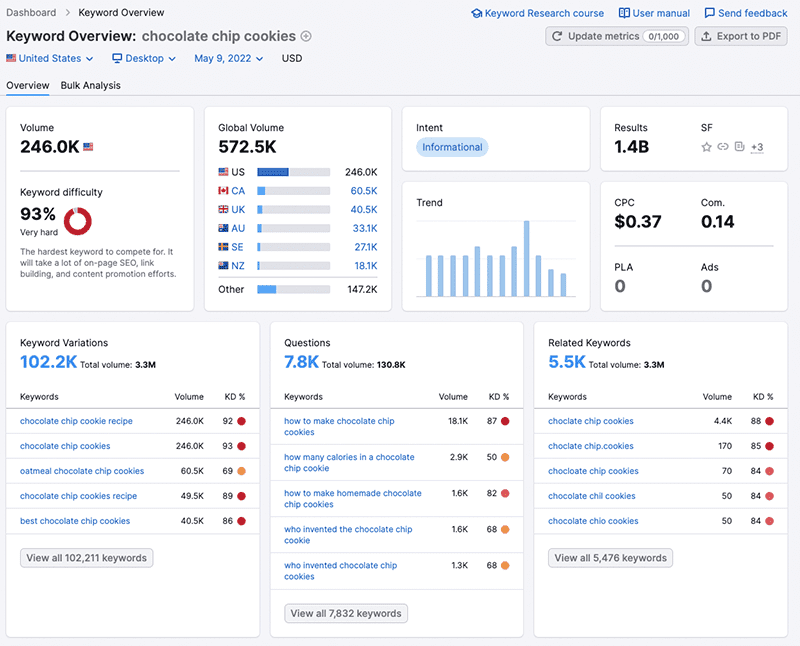
To get even more keyword suggestions in detail, you can use the Keyword Magic tool. It gives you a more extensive list of keywords, along with the same metrics as discussed above. You can also sort or filter this data based on a specific metric.
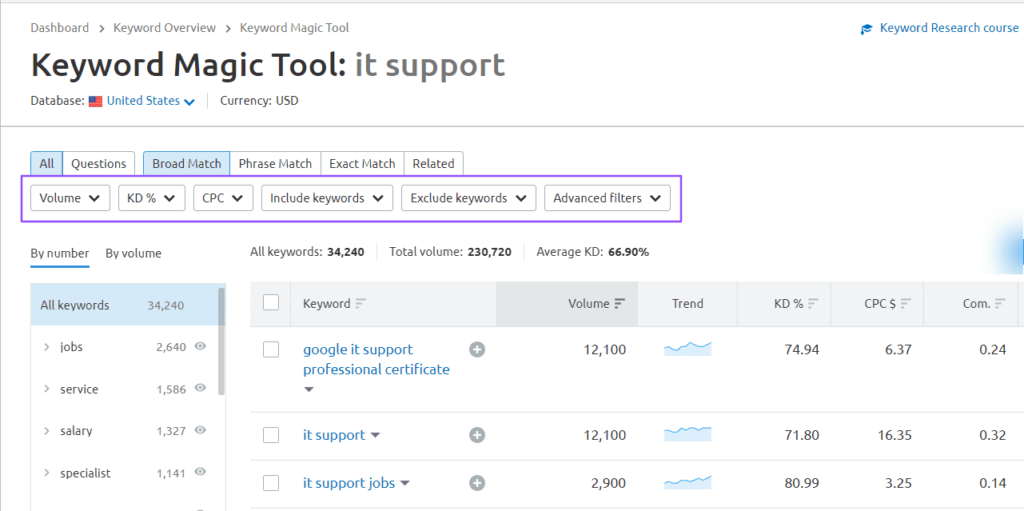
When it comes to keyword research, one of Semrush’s unique features is the inclusion of keyword intent. It tells you whether the search intent is I, N, C, or T (informational, navigational, commercial, or transactional).
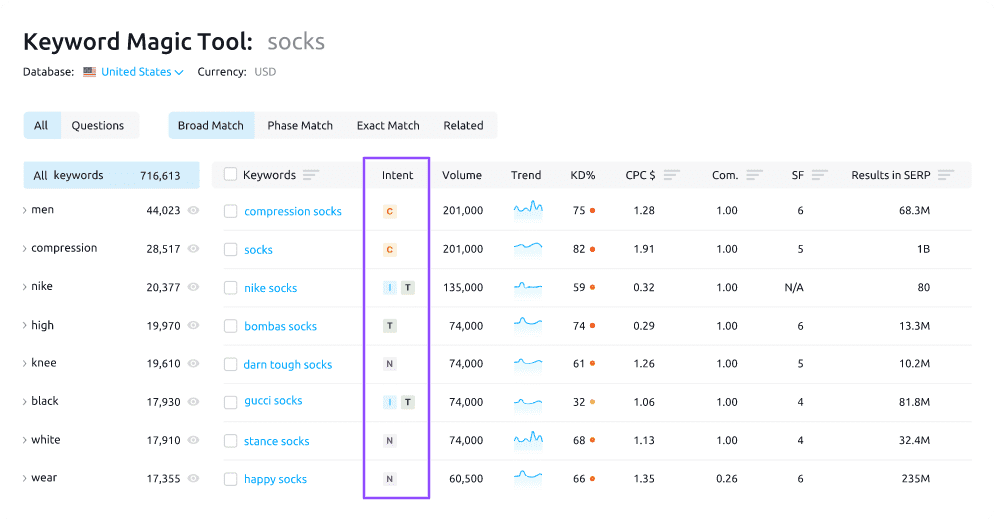
If the intent is informational, that means the user wants to find information on a specific topic. And if it’s commercial, the user is considering a product or service. Navigational intent implies that the user wants to locate a website, and a transactional intent signals the desire to complete an action.
These insights provide you with more context about the keywords than search volume alone. And they help you make better decisions.
The bottom line? Semrush’s keyword research tool is a comprehensive solution to analyze and find the right keywords for your business.
Rank tracking
Rank tracking lets you monitor the position of your website in search engine result pages for the keywords you select. To set this up in the Semrush tool, head over to the position tracker section and enter a domain name.
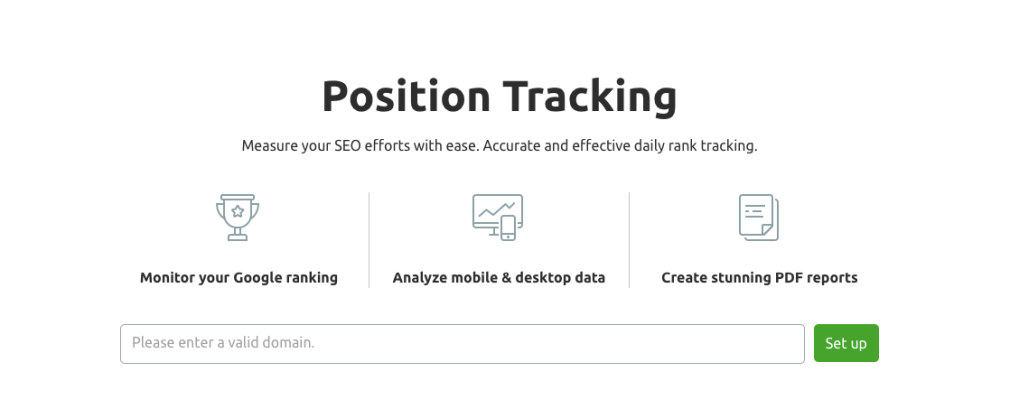
Next, just add the keywords for which you want to track search rankings.
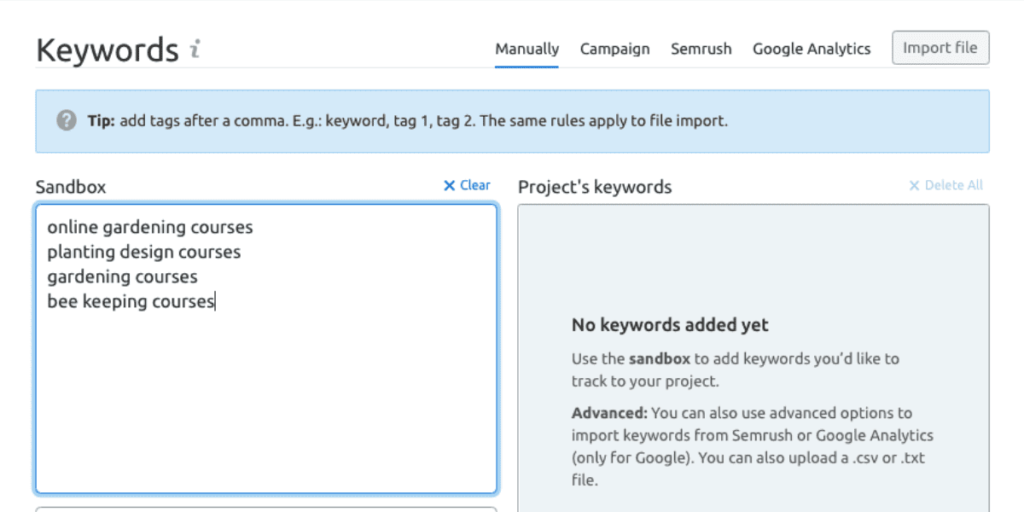
That’s it. You will now get a report showing how your website is performing in the SERPs (search engine result pages), and how the ranking is changing over time.
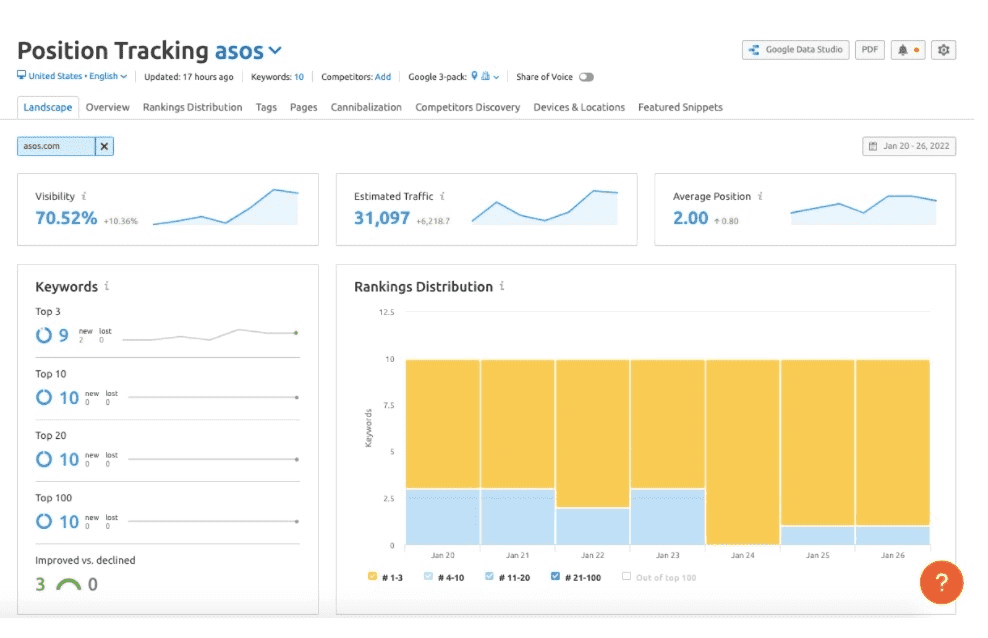
You can also set up email notifications for important events, such as when your website hits one of the top 10 spots, or when its ranking drops for a keyword. Overall, it’s a robust feature that works well in general.
Backlink analysis
A website’s SEO performance depends heavily on the number of backlinks pointing to it from other sites. In fact, according to a study by Backlinko, the #1 result in Google has an average of 3.8x more backlinks than positions #2-#10.
So backlinks analysis is one of the most critical features of any SEO tool. And Semrush doesn’t disappoint here too. Enter a domain name it will show you a vast index of backlinks it has.
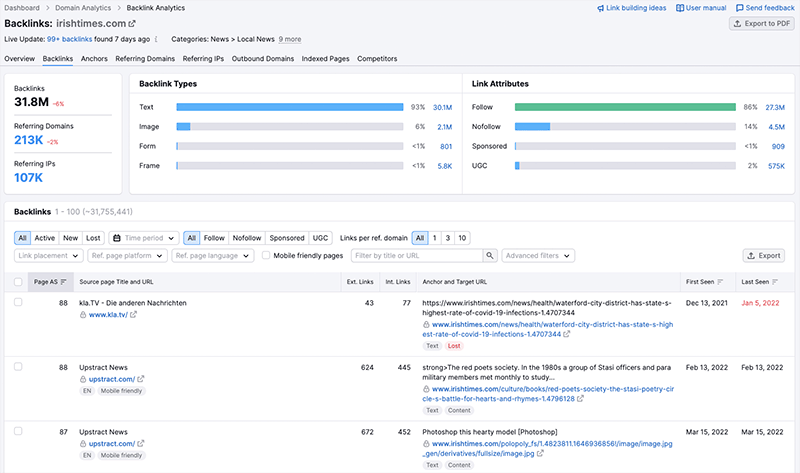
There’s plenty of valuable data here, along with trends showing when a website has gained or lost backlinks. You can also see how valuable each of the links is from an SEO perspective.
Site audit
An SEO audit analyzes your website for on-page SEO factors and lets you identify areas of improvement. According to Geoff Kennedy, Head of Marketing at Sitebulb:
“The goal of an SEO audit is to improve a website’s presence and performance in Google and other search engines.”
That’s why another valuable feature worth mentioning in this Semrush review is the site auditing functionality.

It can help you identify issues like:
- Slow-loading pages
- Duplicate content
- SSL errors
- Crawling problems
- Google’s core web vitals (to assess website speed and stability)
- Missing headers and other metadata
- Keyword stuffing
A great addition to this feature is the ability to export tasks. For the issues you want to address, you can turn them into tasks and assign them to your team members in any of the popular project management apps.
There is direct integration with Trello. And if you use another project management tool, you can connect it with Semrush using Zapier.
Semrush pricing and value for money
Getting access to a large amount of data and competitor intelligence is expensive. For this reason, tools like Semrush don’t come for cheap. If you’re looking for more affordable SEO software, Mangools would be a better fit for you.
The Semrush SEO tool has three main pricing plans:
- Pro: $119.95 per month
- Guru: $229.95 per month
- Business: $449.95 per month
But you can get a 17% discount if you agree to pay for the whole year in advance.
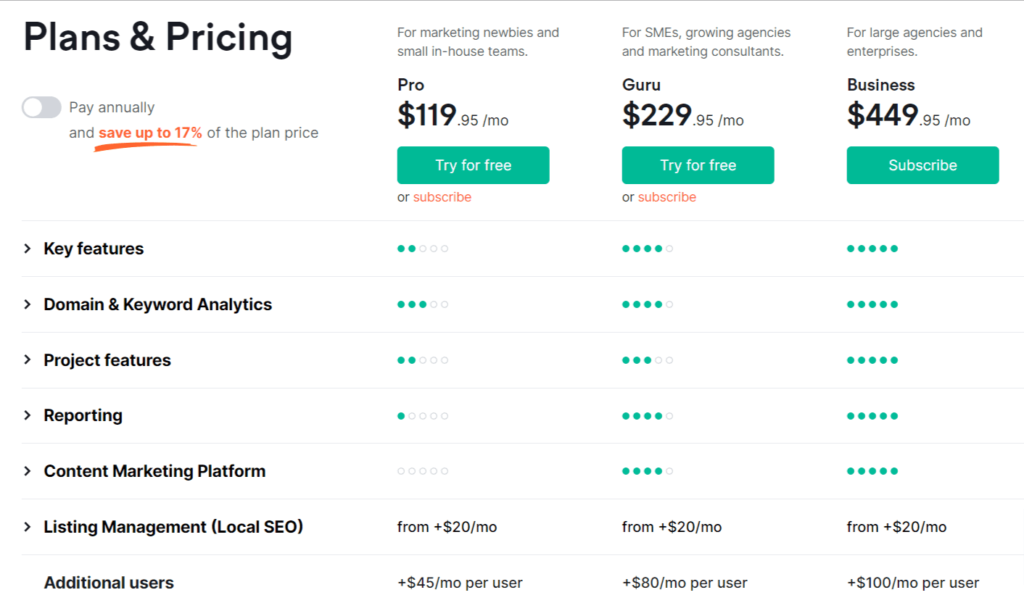
The three plans differ in not just the number of reports or keywords you get to view, but also the features you get access to. With the Guru and Business plans, for example, you get access to content marketing tools not available in the Pro plan.
Also, you can try it at no cost for seven days to see if it meets your needs. But you’ll have to give your credit card details to claim the free trial.
Semrush pros and cons
Now, let’s look at the key factors we liked and didn’t like about Semrush.
Semrush pros
The Semrush tool shines bright in the following areas:
Breadth and depth of features: Semrush tries to provide as many SEO, content marketing, and social media features as possible under a single roof.
A vast and largely accurate database: The accuracy of an SEO tool’s analysis depends heavily on the quality and quantity of its link index. And Semrush fairs well in this aspect.
It boasts of 43 trillion URLs in its link database, which is comparable to competitors Moz (43 trillion), Ahrefs (29 trillion), and Majestic (10 trillion).
Generous reporting limits: As compared to similar products, the Semrush tool lets you pull a good number of reports per day.
PPC data: As seen in this Semrush review, the tool doesn’t just provide intelligence for SEO, but also lets you improve other types of campaigns, including PPC. It goes ahead of other tools by presenting you with detailed CPC competition and distribution reports, ad previews, and panning tools.
Semrush cons
Here are some of the annoying aspects of Semrush:
Pricing: The worst part of using the Semrush SEO tool is that you get only one user account with any plan. So you can’t add any team members. And adding each new user would cost you $45 to $100 extra.
Compare this with Semrush’s leading competitors, who are more generous in this area. Unlike Semrush, you get to add more users in other tools’ high-tier plans.
Another factor that makes Semrush expensive is that some features can only be accessed with an addon. And you pay $200 per month for the addon.
User interface and ease of use: The Semrush interface is similar to other leading SEO software in the market. You get lots of data packaged in the form of lists, tables, and graphs. And everything is easy to understand if you have some background in SEO.
But that doesn’t mean it can’t be simplified. Mangools, for example, has a much better UI that suits even beginners. And it doesn’t even cost as much as Semrush.
Final verdict on Semrush
To sum up this Semrush review, it is a solid SEO tool that gives an abundance of data you need for SEO success.
There are some downsides with regard to pricing and other factors we mentioned above. But overall, the Semrush SEO tool is a strong contender for marketers in highly competitive niches. Because in a competitive market, you need all the data you can get to improve your search rankings. Start your free 7-day trial.
Did we miss anything in this Semrush review? Did you try the Semrush tool? Do you have any questions or comments? Share your thoughts below in the comments section.



This is precisely the sort of review that I was looking for. Reviews like these should come in more often than not; they’re just so valuable.